
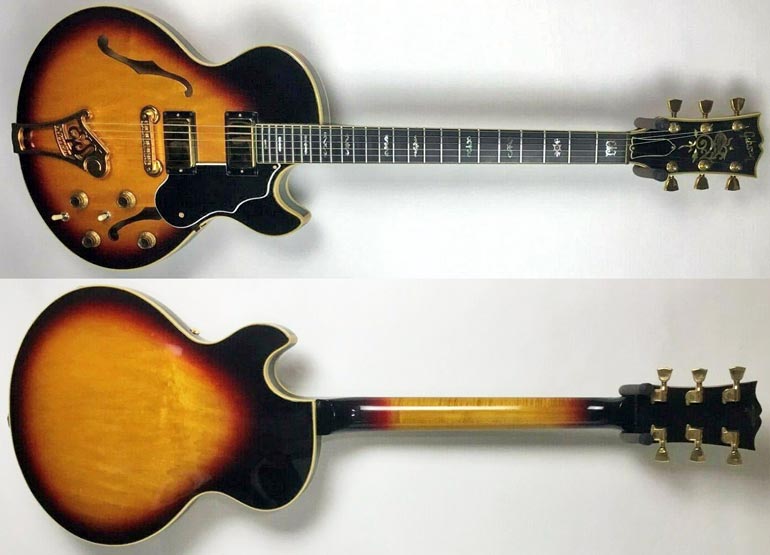
Gibson prototype guitars don't come up for sale too often, and when they do they typically attract a lot of interest from guitar dealers, players and collectors. Back in the 50s, 60s and 70s, all guitar development happened at Gibson's Kalamazoo plant (Michigan, USA). Guitars that didn't make it to production sometimes ended up in the hands of employees, were sometimes dismantled, but often ended "up in the tubes" - a storage area upstairs in the Kalamazoo plant - kept for reference. Guitars were sometimes sold on at trade shows, with the rest moved on when the Kalamazoo plant closed down in the early 1980s. The example above is an interesting guitar indeed, but before story begins, thanks must go to LaVonne Music, Minnesota for use of the pictures (and yes, it is currently for sale).
So what a guitar! A high end Gibson electric acoustic, with gold hardware throughout, bound front and back with stunning abalone and pearl inlays on an ebony fretboard and finished with Gibson's traditional sunburst nitrocellulose finish. Unusually, for a single cutaway, it has the 335-style maple center-block construction, but the most unusual feature of this instrument is it's unique dual-output circuit layout.
Gibson guitar development in the 50s and 60s CMI period was very much about wood. Experiments in construction and design lead to many of the iconic designs that are the classics of today. The Les Paul, Flying V, Explorer, ES-335TD, Firebird, etc. The story is well known. But whilst the 1950s and 60s saw the introduction of new shapes and body styles, the 1970s, or the Norlin period, were all about electronics. There were new body designs, of course, but nothing as original or enduring as the guitars mentioned previously.
Les Paul himself kicked off the decade with his low impedance recording models (the Les Paul Personal which evolved into the Les Paul Recording). These were based on many years of his own research into guitar and recording electronics. Then there was Bill Lawrence - another highly regarded guitarist who had spent decades playing with guitar design and electronics. The circuitry ideas he brought with him developed into the Gibson S-1, L-6S, and the Ripper and G-3 basses. Finally, Bob Moog, known for his development of the Moog synthesiser, developed the RD series of guitars, with their built-in compression, expansion and bright mode circuitry, first shipping in 1976. One final name to mention is Tim Shaw, though his work with Gibson is more typically associated with the very end of the decade: the Explorer 2, Flying V2 and Victory series.

Which brings us to the guitar offered for sale now. It was purchased from Gibson at a NAMM trade show in Chicago "in around 1980" by LaVonne Music, who own it to this day. It is easily date-able by the decal serial number to be from 1977. The tailpiece with it's ES Artist designation gives us a model name, unfortunately one Gibson did eventually use again, in 1979; on the active version of the ES-335, with Bob Moog's 'RD' electronics, the ES Artist.
Pete Wagener from LaVonne explains how Gibson sold him the guitar
Sometime in the early 80's Gibson invited their top 100 dealers to a special Meet and Greet at the Summer NAMM Show in Chicago. After the festivities they opened doors at the end of the room where they had table after table of 1 of a kinds, experimentals, things they started and hadn't finished, etc, and each one of them had essentially a shoebox with a slit cut in the top where you would write down your dealer number and a bid of what you were willing to pay for that instrument. The guitars that I remember getting through that process were a 1938 Specification Non-Cut Super 400 (in sunburst, they also had a blonde but I was outbid), an acoustic violin style bass (similar to the early EB0 solid bodies) that was never finished (no bridge, tailpiece nor tuners), and two ES Artists (which were experimental and technically not prototypes as they never went into production). I bid on them and got them both and at that time I was told by Gibson that they were the only two that had been made. The two that we received were identical in every specification.
The single cutaway thinline body style, with Florentine cutaway, is perhaps reminiscent of the ES-125TD, ES-175D, or even the Howard Roberts Fusion. But this guitar has numerous differences to all of these. The guitar has a long 25 1/2" scale, an all-maple body, with three-piece maple neck, center block and an ebony fretboard. And then there's the electronics... However, this guitar did evolve (eventually) into the Howard Roberts Fusion.
Older Gibson serial numbers have always been problematic as a source of dating information, however, when they moved to decal serial numbers, starting in 1975, a date code was embedded into the serial number. Typically the date code was applied separately from the serial number, and this can be shown here. The date code of 06 shown on the back of the headstock represents 1977. HOWEVER, this only tells us that the decal was applied in 1977; it gives no real information on when the guitar and electronics were assembled. In production guitars, especially those with significant shipping volumes, assembly, finishing and shipping will occur over a few months. For a prototype like this there is no way of knowing how long the development process took; when it started, or when it finished.
So who designed the electronics? And who built the guitar itself? The guitar was certainly built by Chuck Burge. Circa 1977, Chuck had just joined the new Gibson Research and Development team, alongside Bruce Bolen and Abe Wechter. They were effectively the equivalent of today's Gibson Custom Shop. In an interview (to be published) from 2008, Chuck told me a lot about this period at Gibson. He was employed as Gibson's resident artist. He designed guitars, but also inlays, motifs and hardware; he also built prototypes guitars, and batches of show models that would be demonstrated before production started en masse.
Chuck tells the story of this guitar:
Two years before I went to work for them, I was thinking why in the heck doesn't Gibson build something like a slightly larger Les Paul, arched top, f-holes, 335 construction, you know, straight Les Paul neck, 24 3/4 you know... and by the time I got in there, there were other companies already making knock offs of single cutaway type just like that. So I finally talked them into it, after I was there for a couple of years. And I built all the prototypes. And I built a narrow one like the 335, maybe slightly smaller neck. And then one that was maybe slightly bigger than 335 rim size, and then I built one that was 2 1/4" - you know whatever it ended up... that was the thickness. And we were going to call it the ES Artist, and I designed this big brass tailpiece and made a couple of them up. Early on in this thing, marketing called from Chicago and said "great - let's put a lot of gingerbread on it - let's put on F5L mandolin fingerboard inlays" so I did, I built prototypes like that. Couple weeks before the NAMM show marketing comes back and says "nah, it's too expensive, don't show it".
After this, the guitars went into storage at the Kalamazoo plant, but they were demonstrated to Howard Roberts a couple years later, and gradually evolved into the Fusion.
But what about the circuitry? It's harder to be certain about this. The pickups are not typical Gibson PAF style humbuckers. The covers are plain (no pole pieces), somewhat similar to pickups designed by Bill Lawrence in the preceding years. But Lawrence had largely finished work with Gibson by 1977. The passive design with mode switching certainly sounds more like Bill Lawrence's work than Bob Moog's, who was working on the RD series guitars at the same time.
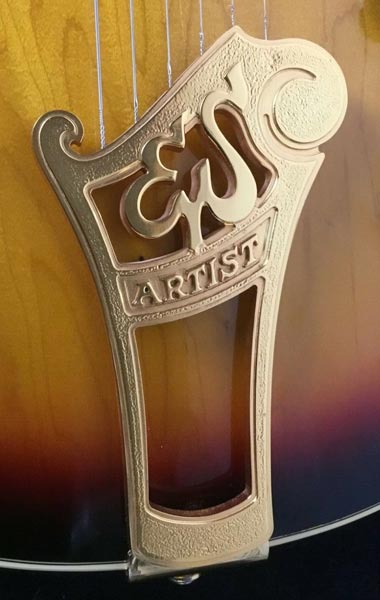
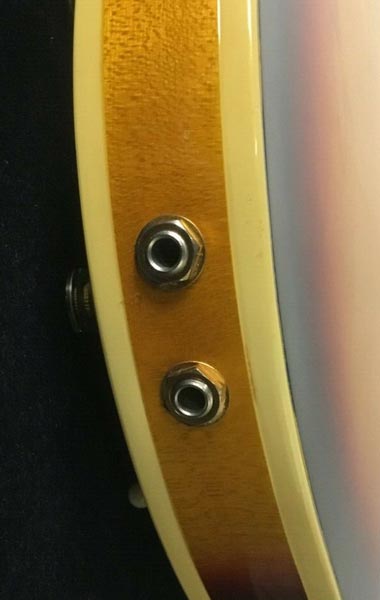
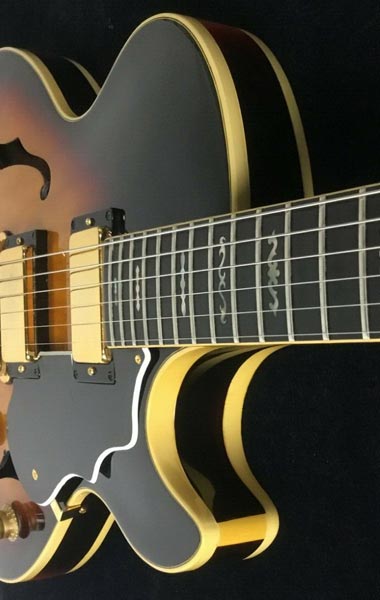
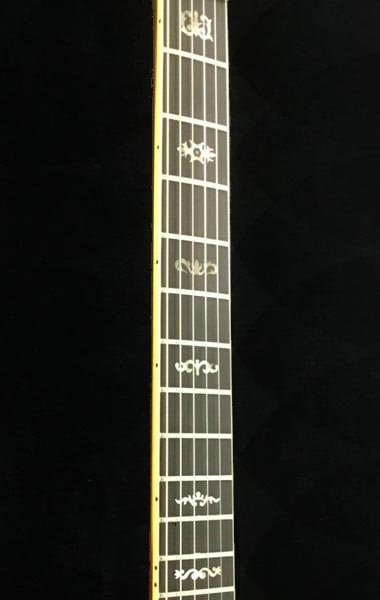
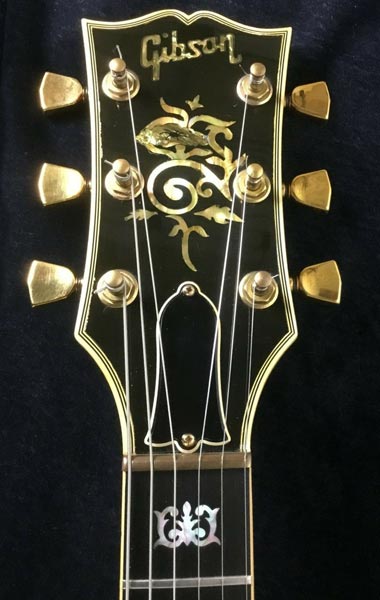
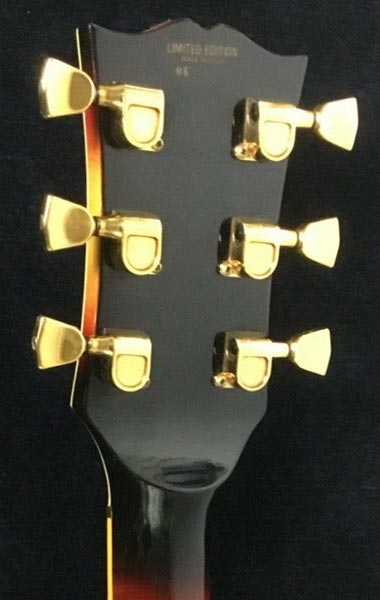
This is clearly a very ornate guitar, with stunning gold hardware and beautifully made. Abalone and mother of pearl inlays giving it a supreme high end look. Burge went on to mix these materials (and some of the creeping vine motif) in his headstock inlay for the Les Paul 25/50.
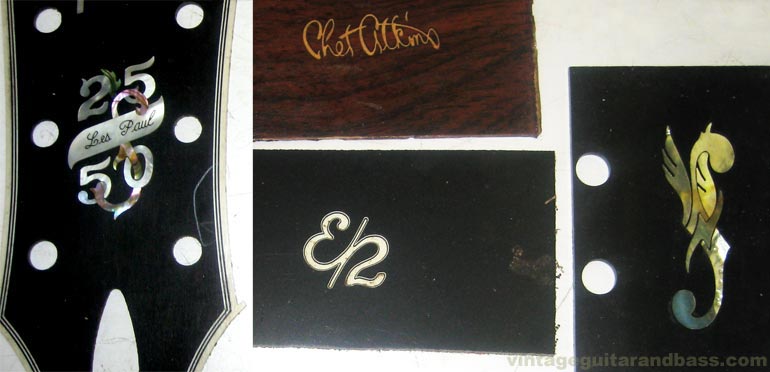
Gibson artist Chuck Burge created numerous inlays for guitars in the mid-late 1970s. The above image shows some of his original templates he still had in his workshop in 2008. From left to right: Les Paul 25/50 headstock inlay mixing pearl and abalone with creeping vine motifs; Explorer 2 logo (below Gibson Chet Atkins signature motif; Gibson RD series 'flying f-hole'. Elements of both the 25/50 and Explorer 2 artwork can be seen in this guitar that predates both of them. The RD 'flying f-hole' also appeared on the 335-style guitar officially named ES Artist.
This is a somewhat unique guitar and an interesting part of Gibson history. The two 'identical' guitars purchased by LaVonne music appear to be the only examples that have surfaced. Could they have had a subtly different body thickness, and represent two of the original three prototype guitars built by Burge? Or were these a small batch of (unshown) show models he made after Gibson settled on a body depth? These questions will perhaps not be answered unless more examples come to light. And what about the ornamentation? Too much "gingerbread"? Or utterly cool? Would it have been a success had it been offered as a production model? If you can add anything to the story of this guitar, particularly who designed the circuitry; or if know the location of siblings with differing body depths, please comment.
$8495
$98000
$4190
£6837